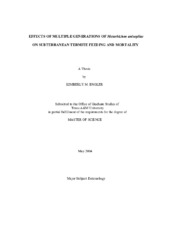| dc.description.abstract | This thesis evaluated the attractancy and mortality of Metarhizium anisopliae on two species of subterranean termites, Reticulitermes flavipes (Kollar) and Coptotermes formosanus Shiraki. There were four specific objectives developed for this research. The first objective was to determine if R. flavipes or C. formosanus were attracted to the mycelium mat matrix of M. anisopliae cultured on rice or corn. The second objective was to determine the tunneling distances of R. flavipes and C. formosanus when exposed to aged strains of M. anisopliae. The third objective was to determine if the fungus caused mortality to populations of R. flavipes or C. formosanus in glass tube bioassays. The fourth objective was to determine if R. flavipes termites are attracted to an ethanol extract of mycelium of M. anisopliae (X-5) or a commercial preferred feeding product (Summon??), and to estimate the percent consumption of the cellulose matrix. The extract and the Summon?? disks were tested in the laboratory using glass plate bioassays, and in the field using commercial termite monitors containing each of the treatments individually. The results with attractancy and mortality varied with age and generation of M. anisopliae mycelia, but all treatments were more attractive and caused more mortality than the controls. When presented with choices, both R. flavipes and C. formosanus did show preference to both the mycelium and the extract forms of M. anisopliae. The 1:1000 dilution of M. anisopliae extract (X-5) was strongly preferred over the other treatments, and all of the dilutions were preferred over the Summon?? and ethanol (40%) treated disks in the laboratory. An analysis of the consumption of test cellulose matrix showed that Summon?? did not attract termites, but it was a phagostimulant. When the undiluted ethanol extract of M. anisopliae was tested in the field, there were more termite visits to the ethanol extract of M. anisopliae (X-5) treated monitors stations, and the fewest termite visits were observed in the monitors containing the untreated fiber pulp disks. | en |


